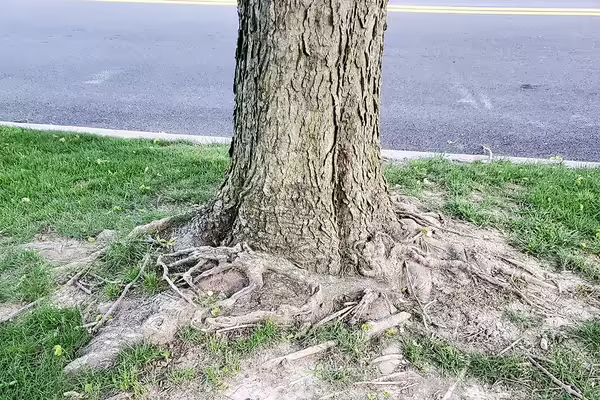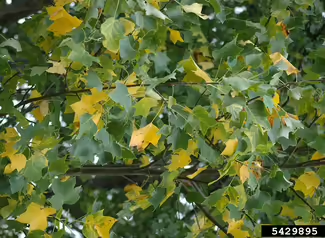
URBANA, Ill. — In urban settings like parks and yards, numerous challenges threaten tree health and longevity. Environmental or abiotic stressors are often the culprit, and as a tree’s health declines, it will become more susceptible to living or biotic organisms like pests or disease. Understanding common tree troubles and their solutions is crucial in maintaining healthy trees.
Abiotic Factors
Abiotic stress factors like drought and physical damage cause ongoing problems. Symptoms of stress include wilting or stunted leaves, early fall color, early leaf drop, and branch dieback. Adhering to proper site selection, planting, and pruning methods will encourage tree health. Protecting trunks and roots from mechanical damage and watering during dry periods will also reduce stress on the tree. Recognizing stress symptoms early can prevent further decline.
Planting Depth Issues
Many problems start at the base of the trunk. Trees planted too deep, where the trunk and root flare are buried beneath the soil, promote rot and shorten a tree’s lifespan. This may appear like the trunk is a telephone pole going straight into the ground. Prevent this by planting with a visible root flare above the soil. Avoid loosening soil at the bottom of the planting hole, as this can cause too much settling. During construction, avoid changing the soil grade around trees and protect the root system from compaction and trenching.
A recently planted tree that is too deep can be lifted and replanted, but it is likely too late to replant mature trees. However, if it is a valuable specimen or historically significant, an arborist may be able to excavate around the root flare with an air spade and regrade the soil around the tree.
Mulching Practices
Mulching is beneficial for trees, but improper mulching causes harm. Avoid plastic and rock mulch as they can create inhospitable conditions for trees. Instead, use organic mulch like arborist wood chips. Apply in a 3-inch layer around the tree, extending to the dripline if possible. This retains moisture, reduces competition from grass, suppresses weeds, and protects the tree from mechanical damage.
Structural Problems
Structural defects like codominant stems, which are weak and prone to failure, can be correctively pruned while young. Remove one codominant stem to encourage one straight, central leader and proper branch scaffolding. For older trees, cabling or bracing may be necessary to reinforce weak areas and prevent branch or whole-tree failure. Be aware of other defects like decay, cracks, splits, and cavities.
Surface and Girdling Roots
Surface roots can be a nuisance, but adding heavy layers of soil or planting raised flower beds over surface roots can cause more damage. Growing turfgrass near the trunk not only competes with tree roots for moisture and nutrients but also requires mowing, causing further damage to exposed roots. The best solution is to apply mulch around the tree to cover the roots while avoiding the root flare.
Girdling roots are another common problem to be remedied at planting time or soon thereafter. Roots that encircle the stem will eventually grow and interrupt vascular flow, leading to symptoms in the canopy like stunted growth or branch dieback. Tree species most likely to develop girdling roots include maples, linden, American beech, oaks, pines, elms, and any species grown in a container. Contact a professional to remove girdling roots over 1 inch in diameter from a planted tree, as this can negatively impact the health of a tree or even cause bodily injury.
Maintain healthy trees by using best management practices and addressing problems early to mitigate pest and disease issues, and ensure trees thrive for years to come.
For more on tree health, download the Tree Care Basics series fact sheets. For questions, connect with a local University of Illinois Extension office from the statewide map.
Sarah Vogel is an Illinois Extension horticulture educator for DeWitt, Macon, and Piatt counties. Gardeners Corner is a quarterly newsletter from gardening experts around the state. Each issue highlights best practices that will make your houseplants, landscape, or garden shine in any season.
Caption: Exposed, girdling, and damaged roots on young sugar maple (Acer saccharum). Photo by: Sarah Vogel, Illinois Extension. Photo available for media download, including credits.
University of Illinois Extension develops educational programs, extends knowledge, and builds partnerships to support people, communities, and their environments as part of the state's land-grant institution. Extension serves as the leading public outreach effort for University of Illinois Urbana-Champaign and the College of Agricultural, Consumer and Environmental Sciences in all 102 Illinois counties through a network of 27 multi-county units and over 700 staff statewide. Extension’s mission is responsive to eight strategic priorities — community, economy, environment, food and agriculture, health, partnerships, technology and discovery, and workforce excellence — that are served through six program areas — 4-H youth development, agriculture and agribusiness, community and economic development, family and consumer science, integrated health disparities, and natural resources, environment, and energy.
